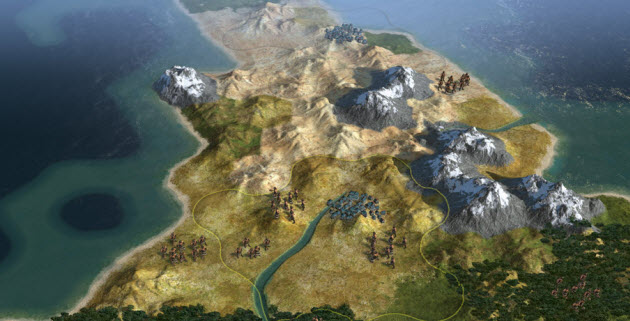
I’ve been playing the turn-based strategy game for a couple of weeks now, and it’s the only game that could have knocked me out of my addiction to StarCraft II: Wings of Liberty. Some have called this the “anti-StarCraft,” since it relies on chess-like, thoughtful thinking rather than frenetic, on-the-fly real-time strategy. It takes me back to the days when I played strategy games on big maps on the floor of my home.
[aditude-amp id="flyingcarpet" targeting='{"env":"staging","page_type":"article","post_id":217511,"post_type":"story","post_chan":"none","tags":null,"ai":false,"category":"none","all_categories":"business,games,","session":"D"}']AI Weekly
The must-read newsletter for AI and Big Data industry written by Khari Johnson, Kyle Wiggers, and Seth Colaner.
Included with VentureBeat Insider and VentureBeat VIP memberships.
Because of its broad reach and attention to detail, it’s no surprise that the whole series has sold more than 9 million units over time. That’s something like $400 million sold at retail, which makes Civilization one of the most valuable properties in video games. My guess is this version of the game will sell great.
I give the game a 95 out of 100 rating, the same rating I gave to Halo: Reach, lower than the 97 rating I gave to StarCraft II, and higher than the average rating of 91 on review aggregator Metacritic. I like it because the single-player campaigns have a lot of variety and always surprise me. Each game you play is different. Overall, the fifth installment is fresh, and that’s no small achievement for a series that game designer Sid Meier started way back in 1991.
Here’s an example of a series of surprises in a single game: As Julius Caesar, I was deep into building coliseums and granaries to keep my population happy. I ignored increasingly belligerent threats from my neighbors and maintained a small defensive force to keep any nation at bay. I had more cities than anyone else and didn’t worry about being attacked. But then Ramesses II of Egypt and Elizabeth I of England conspired against me and launched a surprise attack.
It’s surprising campaigns like that which can keep you busy with Civilization for many hours. Now that I’ve spent so much time with the game, I can appreciate the design that went into the user interface, which is very uncluttered given that you have to keep track of dozens of armies, workers, and cities. You can automate the workers to make improvements and just focus on the big stuff, or you can micro-manage if you wish. The streamlining of a complicated interface isn’t easy to do, and others could learn from this interface on how to design complicated user software.
[aditude-amp id="medium1" targeting='{"env":"staging","page_type":"article","post_id":217511,"post_type":"story","post_chan":"none","tags":null,"ai":false,"category":"none","all_categories":"business,games,","session":"D"}']
You also have to deploy your armies with terrain in mind, since you can’t stack them. In the past, it was always unwieldy to stack 10 different military units in a single spot. It was hard to see which units were in a particular location. And there was no real sense for how big an army was when you were attacking it. Now, you have to put your artillery in the right high positions, protected from frontal attack. So there’s more actual strategy and maneuvering that you have to consider when fighting battles.
Sea transportation was also a nightmare in previous games. You had to build separate naval units and move them to a particular location before your soldiers or workers could board the ships. Now you just move a land unit into the ocean and it automatically boards a transport ship.
I played the game on the Warlord level, just below normal, because I found it hard to stay alive long enough in the early years of empire building. Also, I had to play the quick version of the game because it took far too long to build new units in the game. Otherwise, if you build a unit, chances are it will be obsolete by the time you’re done.
[aditude-amp id="medium2" targeting='{"env":"staging","page_type":"article","post_id":217511,"post_type":"story","post_chan":"none","tags":null,"ai":false,"category":"none","all_categories":"business,games,","session":"D"}']
The game isn’t perfect in that it still takes time to execute your orders once you end your turn. The game makes you to wait while it makes all sorts of changes to the world. But the good thing is that it never crashed while I played with an Nvidia Fermi-based desktop computer. I played the DirectX 11 version of the game and it was both beautiful and responsive.
This game reminds me of why I love everything Civ. I’m looking forward to seeing what a smaller Civ experience will be like when Sid Meier launches a long-awaited Facebook version of Civilization sometime soon. By the way, don’t tell my bosses I’ve been playing a lot. They don’t know I’m spending all my time “researching” games.
Here’s a video review by GameTrailers.com below.
VentureBeat's mission is to be a digital town square for technical decision-makers to gain knowledge about transformative enterprise technology and transact. Learn More
